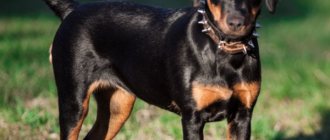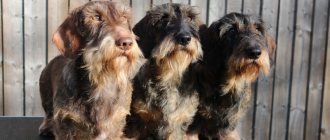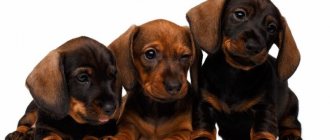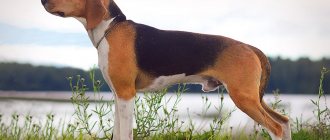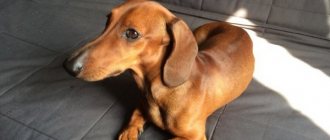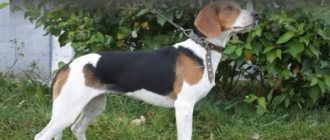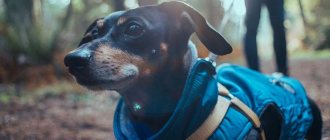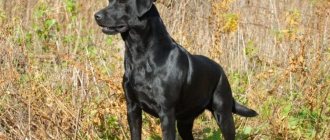Hunting for fox, badger and other animals. Appearance of purebred representatives, description of standard colors and coat types. Temperament and behavior of dachshunds of all sizes. Basics of caring for an adult dog and a puppy.
The dachshund is suitable for working in a hole and above the ground. This breed is considered one of the most versatile. Both standard-sized and miniature dogs are used in the fishery. They go with them to:
- Fox;
- Basruka;
- A rabbit;
- Ungulates.
The small and nimble dachshund has an excellent sense of smell. Noticing the tracks of the beast, she quickly finds the place where he hid. In the hole, the dachshund enters into a fight with him and drives him to the surface. For large animals on the ground, this dog uses different tactics. She pinches and bites the prey's legs, forcing it to remain in one place, where the hunter then approaches.
Before going out on a serious hunt, these dogs are tested in an artificial hole or in a pen. Individuals with good abilities show successful results already on the first baiting.
Appearance
For dachshunds, it is customary to measure not the height at the withers, but the chest circumference. For standard dogs it is at least 35 cm, for dwarf dogs - from 30 to 35 cm, for rabbits up to 30 cm. Measurements are taken when the dog is 15 months old. The maximum weight reaches 9 kg.
These dogs have an elongated body with short legs. The narrow head is held on the neck with a proud posture. Intelligent eyes are oval shaped and dark brown in color, ranging from bright red to deep hazel.
The tail is of moderate length, straight, but a slight bend is allowed at the end. It continues the line of the back, which should be strong and muscular. The ears hang, close to the cheekbones.
Dachshunds have the following colors:
- Solid: yellow, red, yellow-red, black hair allowed;
- Tan: on a black or brown background, spots of red color in certain places;
- Brindle: dark background with streaks;
- Marble: gray or beige spots on a dark background.
Important: Wirehaired dogs have a standard boar coloration. It ranges from light to dark shades and can be compared to the color of fallen leaves.
Health
Dachshunds are prone to musculoskeletal diseases, especially intervertebral disc defects due to their long spine and short chest.
The risk is increased by obesity, jumping, rough handling or physical exertion. About 20–25% suffer from disc defects.
They also suffer from swimmer's syndrome or osteoporosis, in which the puppy's legs move apart and he is forced to crawl on his stomach. This condition occurs in many breeds, but is common in dachshunds.
The reason is a lack of minerals and sunlight. In any case, if your dog is sick, be sure to see a veterinarian!
Character
The dachshund is an active, intelligent, but balanced dog. She can make her own decisions, which is so necessary when working in a cramped hole. Working individuals have viciousness. There is no aggression towards humans.
If at work the dachshund is an energetic and purposeful animal, then at home it turns into a sweet and friendly pet. After a hunt or a long walk, she always rests, but her sleep is light. There is cunning in character.
Dachshunds have no problems with children. Jealousy does not appear; these are sociable and sociable dogs. They are often paired with other pets. When walking, a dachshund never behaves melancholy; it follows the scent, sniffs out dogs and cats.
With proper upbringing, hunting instincts are not visible in everyday life. Therefore, cats do not become prey for hunters with short legs. The dachshund loves toys, but quickly guts them or hides them. Her bark is loud, so she always knows when guests are coming.
Important: Wire-haired individuals have a softer and more flexible character. They are silent more often than they bark. They probably owe these qualities to their ancestors – pinschers and terriers.
Mining work with a dachshund
The character of the dachshund is suitable for burrow hunting. She is brave and aggressive enough to drive the beast out of its hole. And at the same time it is prudent not to tear it. This is important during commercial hunting, when the skin is especially valuable.
The dachshund is talented at tracking and chasing animals, and is predisposed to work in a hole. The dachshund will easily penetrate even a difficult hole. Short legs help the dog dig quickly. The dog is active, sensitive, feels free in the hole, moves quickly along the passages when chasing an animal.
There are three directions in using dachshunds for burrow hunting.
- The first direction is dachshunds, which from childhood begin to work in natural burrows. These dogs can be excellent hunters, but do not have field certificates and therefore fall out of breeding.
- The second direction is dachshunds, which are trained in an artificial hole and have field diplomas. Often these dachshunds do not take part in hunting, but they are valuable as producers.
- The third direction is dachshunds who passed the exam in an artificial hole, received a field diploma, and then became hardened by hunting. They are used as producers, periodically improve their skills by baiting in an artificial hole, and delight the owner with work on the animal during the hunt. This combination maximally develops all the dog’s hunting skills.
Who is the breed suitable for?
Dachshunds get along with people who have an active lifestyle. Recently, hunting with dogs of this breed has been losing popularity, but their number in houses and apartments has not decreased. Dachshunds do not let their owners get bored.
Despite their small stature and good-natured look, these dogs can fight back. Some individuals with tendencies towards dominance periodically try to undermine the authority of the owner.
These are the reasons for refusing a child to purchase a dachshund. For a high school student, this breed does not pose a danger. Dachshunds often live with older people.
If you don’t have time for long walks or daily games with your pet, then it’s better to give up dreams of a brave dog with short legs and a long muzzle. Otherwise, care is not difficult; a novice dog breeder can handle keeping a dachshund.
Dachshunds are bred to live in a house or apartment. They will yearn away from their owner, and in winter they will not withstand frost. They need to participate in the life of the family, watch the owner and receive a large portion of affection from him.
In a kennel, smooth-haired and sociable dogs will not withstand the cold and loneliness. Even hunting dachshunds are kept in the house. They are walked regularly, ensuring uniform physical activity.
Dachshunds are mainly purchased by fans of the breed, hunters and those who want a pet with a lively mind and cheerful disposition.
Photo gallery
No matter what anyone says about representatives of this breed, it must be admitted that they are excellent hunters. Proof of these words is a selection of photos demonstrating their excellent hunting skills.
Puppies: growth and care features
Dachshunds are born at different weights. There are cases when puppies weighed 500 g, and subsequently they grew to standard sizes. However, at birth it is difficult to determine what kind of dog the dog will be. The structure of the coat is immediately visible, but the color changes slightly.
Dachshund puppies are very energetic, playful and a little clumsy. Therefore, they make sure that they do not jump from great heights. Wires, shoes, and furniture are protected from them. When changing teeth, wooden and plastic products are most often affected.
A separate room, a free cage during the absence of people in the apartment will help to avoid negative consequences.
Dachshunds are affectionate to their owners, but can be stubborn, especially as puppies and teenagers. Education begins from the first days of being in a new family. The puppy is praised for good behavior and taught a sleep schedule and regular paw washing.
The meaning of a dachshund's bark when hunting.
The dachshund gives the hunter clear signals with its voice - what kind of work it is doing. The voice is informative, ringing and incessant in close proximity to the animal. With the help of barking and whining, the dog indicates the detection of an animal. The working, “rutting” bark of a dachshund differs well from its other sounds. A timbre change in the voice means for the owner the beginning of the duel stage. The lower the dachshund sounds, the more aggressive it is, which means the dachshund is ready to “take.” Having taken the animal, the dachshund shakes it, holding it in its teeth, and continues to growl dully. The timbre of a dachshund's bark is full and clearly audible from underground. After several hours of voice work, hoarseness appears. A working dog does not bark in vain, but only when there is an animal in the hole. Empty dogs do not go hunting - this is a serious vice.
Features of care and feeding
The frequency and type of grooming depends on the type of dachshund's coat. Short hair does not need frequent washing; it is wiped with a damp cloth, and after a walk the paws and belly are washed.
Sometimes they comb with a brush with frequent and short teeth, which is a kind of massage. Long-haired dogs are bathed with shampoo 1-2 times a month and brushed every day.
Wirehaired dachshunds are trimmed. Their fur practically does not fall out on its own, and old hairs then prevent new ones from growing. Skin irritation, dandruff and itching may occur. Once every few months, mature wool is plucked in a special way, or a small part of the oldest hairs is constantly removed.
Important: During shedding, short-haired dachshunds leave behind small, spiky hairs. Therefore, long-haired or wire-haired dogs are more suitable for allergy sufferers, asthmatics and lovers of cleanliness.
Pets with short hair are dressed in overalls and sweaters in winter. Dogs with a hard coat have a developed undercoat, so they do not notice frosts or rain.
The diet for dachshunds consists of common foods that can be given to dogs. Meat, offal and fish in combination with porridge or cottage cheese are the daily menu. 1-2 times a week chicken or quail eggs, berries, chicken or turkey throats are added to it.
A dachshund that eats properly, goes outside every day and spends time playing with its owner can live up to 17 years. There are a lot of long-livers in this breed.
Fox terrier
The homeland of the fox terrier is England. The first descriptions of a small hunting dog for hunting animals in holes date back to the 16th century. The Fox Terrier breed was developed from small hunting dogs that Roman soldiers brought with them when they conquered the British Isles. The Roman troops left the islands, but the small fox hunting dog remained. Currently, the Fox Terrier is the property of England.
At the moment, there are two standards for the Fox Terrier breed: – Wire Fox Terrier; - Smooth Fox Terrier. Despite the name, the difference is not only in the type of coat, they are completely different dogs, with different habits and characters.
The Fox Terrier is the most common breed not only in England, but throughout the world. The Fox Terrier has for a long time proven itself to be the best fox hunter, despite its small size, it has enormous power and courage.
With a dachshund for ungulates
The dachshund is indispensable for any hunting and even for hunting ungulates and picking up wounded animals, if it is not very cold in winter or the trip is organized by car. One day I was waiting for a roe deer in a perch built on a tall pine tree. It was already dark when the goat came out onto the salt lick. Peering intensely into the darkness and aiming at him first with my left, then with my right, then with both eyes at once, I, without moving, held the gun pointed forward until the next time he raised his head. After the third attempt to aim, I realized that I couldn’t wait any longer (the darkness was becoming impenetrable) and fired. The goat rushed straight under my pine tree, then sharply to the side behind the tall trees and, hiding behind them, disappeared into the dense pine forest.
I
I was terribly annoyed.
The goat did not fall, but walked away with good swings. One thing was encouraging: when he galloped away, there was too much noise, as if he was being thrown from side to side. Twigs, branches, and young trees crackled; the goat ran indiscriminately, just to get away. Experience suggested that he might be wounded. Having quickly descended, I followed the escape path of the wounded animal, but when I came across dense thickets, I stopped searching. But there was another hope - Linda. Coming out of the forest and not without difficulty finding the hidden bicycle, I flew home like a bullet, as far as possible at night on a forest road. As
soon as I entered the apartment, the dachshund immediately felt my excitement and excitement, these feelings were immediately transferred to her.
She didn’t even begin to sniff the backpack, as usual after a hunt. As soon as it was opened slightly, she immediately jumped in, although previously she had done this with great reluctance. I accompanied my actions with instructions. Linda must know in advance what will be required of her. “Linda, forest, goat, search,” the dog received such commands at home. And, oddly enough, she understood everything perfectly. Arriving
in the forest, I took Linda on a leash, and she followed me to the salt lick.
Twenty meters away, the leash was already ringing like a bowstring from the strain, the earth was flying from under the dog’s feet. Having
gone out to the salt lick, the dog buried its nose in it and began to vacuum the ground, its tail fluttered like an antenna in the wind, all I had to do was indicate the direction of the search with my hand and let Linda off the leash.
The dog immediately began to bark loudly and seemed to take the goat’s route. All I had to do was stand and wait, reading the dachshund’s voice. And then the yapping wandering through the forest stopped in place and turned into barking. The voice came from the dense bush. I took the gun at the ready and climbed into the thickets, illuminating myself with a flashlight. There was no need for a gun; the goat lay there, hit in the neck with four bullets on the spot. What
would I have done if I didn’t have a dog, and such a smart one at that? I would have ruined the game.
Linda once again did a great job and helped me out. It was three o'clock in the morning. Case
two.
While we were still serving near Chita, when we went hunting as a team, we usually took a Ural car from the communications center. The commander of this unit was not a hunter, but he always gave us a car. One winter he received a new assignment and before leaving he asked to take him hunting, to show him the taiga, the process itself and the work of a dachshund. He himself owned a large breed dog, had heard a lot about Linda, but could not imagine how she could participate in the hunt for roe deer, especially in winter. just
arrived at the hunting grounds and began to equip ourselves when we saw two roe deer standing about 200 meters away, apparently disturbed while lying down by our gatherings.
Dawn was beginning to slightly dissolve the darkness of the night; the coming day promised to be successful. “ Well
, the hunt has begun,” Alexander warned the commander, loading his KO-44.
Positioned near the fender of the car, he fired. The goats hardly reacted, darting from side to side, they again froze in place, overlapping each other. Alexander took aim more carefully (visibility was not very good) and fired a second time. One of the roe deer flew up like a candle, and they separately rushed into the birch groves. It was obvious that one of them was hooked. Andrei and Alexander, taking their guns, went after the loot. However, following the tracks, they found only a few drops of frozen blood. The wounded animal, first at a swing, and then at an even pace, walked along the valley along the hill. It was necessary to start the pursuit. Andrey, taking Linda with him, because... The roe deer, beaten and tired from the chase, will try to hide in the support, and rushes after him. The dachshund quickly picked up the trail and rushed forward with a ringing bark, despite the snow and Siberian frost. Excitement drove the dog, and adrenaline in the blood warmed the body. The guys and I stood near the car and, listening to the dog’s voice, predicted events. The yelping quickly faded away, and it became clear that the goat had gone far. But then the barking switched to low notes and stopped in place. Everything is clear - Linda has caught up with the goat and is holding it until Andrei approaches. He, in high boots and a sheepskin coat, clearly lagged behind them. After a while we hear a shot and again the loud, retreating bark of a dog. And again: barking, a shot, the retreating barking of a dog. After the third shot, the dog suddenly fell silent. Minutes of painful waiting dragged on. God be with him, with the goat, the dog would be alive. About 20 minutes later Andrei appeared from behind a distant copse. He was dragging a huge goat with difficulty, and Linda, tired and already starting to freeze, was jumping behind him, waddling in his tracks. Heading
towards the car and passing the goat beds, the dachshund suddenly stopped and began to carefully sniff out the holes of the goat tracks, plunging his head into them up to his ears.
Unraveling the traces of the goat's mud, Linda silently wandered to the birch island, which served as a refuge for the second goat. A
little later, a dog barked from the birch forest.
I asked Alexander to take the carbine and see what was happening there. It was clear from the dachshund's voice that she was barking at a goat. Alexander doubted and did not want to go for a long time, calling the dog an empty nest. He believed that after so many shots, dog barking, our screams and conversations, all the game in the area should scatter several kilometers. However
, I managed to convince him, because we often hunt together, and he knows the value of my dog.
Taking the carbine, he headed towards the grove and disappeared between the trees. Suddenly a shot rang out and we heard Linda's joyful, squealing yelps. Alexander appeared from the birch forest, dragging a large goat. This is how Linda helped us get two roe deer. incident
occurred in late autumn; in some places there was snow in white blots, but mostly there was still black trail.
By this time the hares had already turned white and were far visible on the dark ground. The three of us went out: Linda and I, Alexander Bystritsky and another friend to chase the hares, and at the same time the roe deer. After
walking through the hills all day, having caught a couple of hares each, in the evening we began to get ready for the car.
Linda, who had been sitting in the cabin all day, was released into the wild. She rushed around - kneading bones, greedily inhaling the fresh smell of the evening taiga with its traces of the animal world hidden for us. While the dachshund was busily vacuuming the area with its nose, we decided to have a snack and get ready to go home. Unexpectedly
, in the copse, about 100 meters from us, some movement occurred.
Having looked closely, we saw a roe deer standing half-sided towards us. I asked Alexander to remove it from the carbine before Linda scared the goat away. It was extremely inconvenient to shoot. The GAZ-66 has nothing to lean on, so I had to aim from my hand, leaning against the cabin. After
the shot, the roe deer darted to the side, crossed the clearing and disappeared into the dense bush.
The dachshund was ready for battle even before the shot. She saw us take up our weapons and begin to aim. All her attention was focused in the direction of the barrel, and after the shot, the command “Take” and the roe deer running, the dog rushed after the goat. I
took the gun and followed.
However, the dachshund's actions began to disappoint me. After running a hundred meters after the goat, Linda turned sharply to the right. I was perplexed and indignant - what’s wrong with the dog? The roe deer clearly walked straight, without turning anywhere, but the dog stubbornly moved to the side. I thought that the dachshund was on someone else’s trail, and began to persistently call and scold the dog. What a waste of time when it's time to go home. However, she, without reacting to me at all (which happened extremely rarely), stubbornly went her own way, climbing further and further into the dense alder forest. Realizing the futility of our efforts and assuming that we had missed the goat, perhaps even missed it, I got out into the clearing and went to the guys. At this time, the sounds of a strong struggle came from the bushes: crackling, barking, growling - it was clear that either Linda was tearing and tearing someone, or her. I turned around sharply and rushed to help. At that moment, a roe deer flew out of the bushes, followed closely by Linda, barking furiously. The
donkey runs straight towards the car, frightened, not seeing anything in front of her: the main thing for her is to escape the chase.
I actually found myself opposite the goat, between friends and the dog. It is impossible to shoot, it is very dangerous. Therefore, without any leash, I throw up the gun and shoot in front of the goat in the hope of stray buckshot, but, naturally, I miss. After my shot, Linda realizes that her work comes next. She increases her speed even more, while jumping she grabs the goat’s tail and holds on with a death grip. The roe deer, from such a surprise and its sharply heavier rear, stops short and falls on its hind legs. Linda quickly climbs up the roe deer's body and, grabbing it by the throat, throws it to the ground. Something unimaginable begins: a ball of intertwined bodies tumbles around the car, the roe deer jumps up, Linda knocks it to the ground again. “Horses and people are mixed up in a heap…”, and only I run around them with a gun at the ready and don’t risk shooting. Finally they tumbled over the back side of the car, the roe deer’s strength leaving. All I had to do was lightly kick the dog back, because... It was dangerous to do this with your hand - the dachshund was in a state of blind anger. A shot to the head interrupted the goat's suffering. When
cutting up the carcass, it turned out that the bullet from the carbine passed through the flesh of the right buttock, without hitting either the bone or large vessels.
This unlikely incident happened to us while hunting. Analyzing Linda’s work on the roe deer, I remember that a year before, in winter, the dachshund had already worked in a similar way. Our
bosses had some kind of anniversary.
Alexander Bystritsky and I were asked to get a roe deer, giving them a day off and allocating a car. Having
driven further into the forest lands and leaving Linda in the car, we went on foot.
There weren’t very many traces of roe deer, but some clearings were dotted with wapiti along and across. We decided to try our luck. Less than three hours had passed before we managed to kill a decent bull. The hunt foreshadowed to be successful, but they ordered a roe deer, and it still had to be harvested. Until
evening we combed the near and far surroundings, but all in vain.
Having met at the agreed place, we headed to the car to move to another place, and then in the distance we saw three roe deer feeding. The distance was three hundred meters, and the roe deer were moving, albeit slowly. There is nothing to do - you have to take risks. Alexander pressed himself against a pine tree and fired from his carbine. The roe deer took off and disappeared behind a slope. When
they got to the feeding area, they found a drop of blood.
So, there is still a chance. Having picked up the trail, we began to pursue the wounded animal. The small drops of blood left along the trail became fewer and fewer. The roe deer walked with good swings, and only after breaking away from the distance did it begin to walk. Everything indicated that the wound was weak. The short winter day was coming to an end. And again the main bet had to be placed on Linda. I
ran after the dog, and she immediately got to work.
The pace of the pursuit dropped: walking through deep snow, Linda picked up a goat trail, there was almost no blood and it took a lot of time to find the right trail. We realized that we were in a hurry with the dog. I had to put Linda in my bosom and drive the roe deer further in the hope that she would get tired. The roe deer led us in zigzags along the slope of the hill - up and down... Our pea coats were soaked through with sweat, our feet in felt boots became cast iron, but we knew that it was worse for the roe deer, because it was wounded. Several
times the crackling of bushes was heard ahead; at these moments Linda tried to escape from captivity.
Apparently, the roe deer is somewhere nearby, but if we don’t take it soon, we’ll miss it completely. The darkness of the night began to fall to the ground. Once again, running down the trail, we heard a quiet crash ahead. Linda became hysterical and was eager to fight. There is nothing to do, we are taking risks, our only hope is in the instincts of the dachshund. Nothing depends on us anymore. Linda
, as always, tirelessly and recklessly, not noticing the deep snow, rushed in pursuit, leaving a loose furrow behind her.
The fresh smell of the goat excited and energized the dog, making its voice sound like a continuous bell. The dog was already anticipating victory. And indeed, not even five minutes had passed when we heard a heartbreaking scream in the night. My heart sank with fear for the dog: suddenly, in the excitement of the chase, she ran her eye into a branch, or pierced her belly with a branch of dead wood. We, without hesitation, rushed to the place of the animal's cry and saw a roe deer lying, screaming throughout the taiga, trying to get up, but its hind legs were tightly pressed to the ground, there Linda was holding the roe deer by the buttocks with a death grip and pulling her towards her. After
the wounded man was found, the picture became clearer.
The roe deer was wounded in the right front leg, the hoof was shot off, so there was little blood. When Linda caught up with the wounded animal, she grabbed him in a jump, landing, the roe deer got stuck in a natural horn between a birch tree and a tall wild rosemary bush growing nearby. Linda had only to stop her from getting up, which she successfully did. I
had to be surprised and admired while looking at the work of a hunting dachshund.
There is so much intelligence, determination, energy and hidden potential in her. Hunting and game management
Sergey Kosmachevsky
Separation by coat
The indefatigable imagination of breeders and breeders divided the breed into varieties based on their coat. Today, dogs are distinguished with three different coats: smooth-haired, wire-haired and long-haired.
The most ancient are smooth-haired representatives, with fur that fits tightly to the body. The short fur is so densely packed on the animal’s body that it shimmers in different colors in the sun, shimmering like gloss. Thick and short hair perfectly protects the dog’s skin from dirt and extreme wetness.
Wirehairs have a very hard coat. And under the top coat there is a dense undercoat. A touching feature of wire-haired dogs is a small beard and mustache and eyebrows, making pets, even puppies, look like aged sages.
The long-haired dachshund is the shaggiest of all species. Soft wool, as if slightly curled in curlers, very pleasant to the touch, shiny and silky. The standard does not allow excessive curling, so representatives of this species often have straight but long hair. Certain parts of the body, such as ears, tail, hind legs, are covered with hair more densely.
Optimal diet
A balanced diet plays an important role in maintaining a healthy dachshund. When creating a menu, it is necessary to take into account that dogs have a high need for microelements from early childhood, since they are genetically affected by “dwarfism.”
The optimal menu should consist of natural, fresh products. Be sure to consume dairy products, meat and grains.
- Newfoundland - history of the breed, education, care + 73 photos
Chihuahua - history of the breed, description, temperament, attitude towards people and animals, care + 92 photos
Brussels Griffon - history, modern appearance, standards, character and content + 77 photos
If you are an active and active person, then a dachshund will perfectly complement your company.
Fast and energetic, she cannot sit in one place for a long time, but is always ready to guard and protect her owner.
